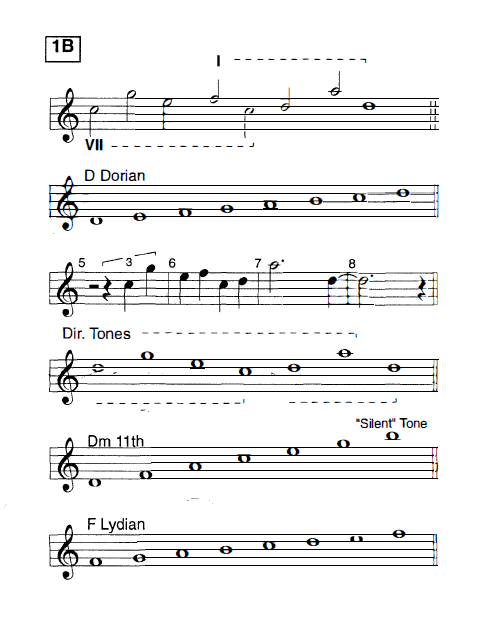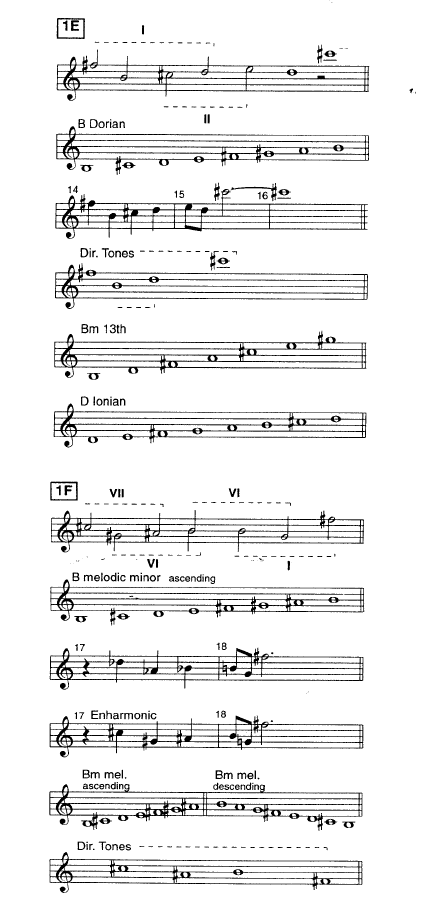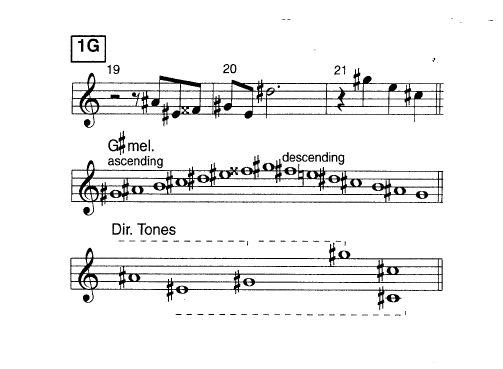The Harmony of Bill Evans (3b) “TIME REMEMBERED” – MODAL ANALYSIS (with sheet music)
This analysis totally ignores the harmonic progression composed by Bill, in order to observe the theme as a complete entity; one that doesn’t need harmony to prove its existence.
In the Modal period (pre-Bach), polyphony reigned supreme; harmony was accidental and therefore not a factor in determining the form or length of a composition. The theoretical basis derived from this period was the MODES or scales: Ionian, Dorian, Phrygian, Lydian, MixoLydian, Aeolian, and Locrian, all beginning on the pitch “c.”
After Bach, the modes disappeared, or rather, were swallowed up, allowing for a synthesis which gave birth to the major/ minor system and a theory of harmony based on 12 major and 12 minor scales ( called scales to differentiate between the pre-Bach Modal period and the Tonal post-Bach era). This tonal period lasted roughly 300 years before a new and higher synthesis-Atonality-came into being.
When a synthesis is reached, it always inherits the previous period. Inherent in the Tonal system is the Modal system; inherent in the Atonal system are both the Modal and the Tonal systems. Bill Evans was born with this awareness, and through his study of the Schoenberg harmony, counterpoint, and compositional books, he created his wonderfully rich compositions, full of the past and present and achieving a new synthesis: the conscious merging of classical music with jazz.
There is a term coined by Gunther Schuller: “Third Stream Music.” It means the synthesis of two streams, classical and ja,zz, to produce a third stream. Bill Evans’ compositions are Third Stream, and the following analysis of “Time Remembered” is an attempt to prove that statement true.
Here are eight examples that break down the theme into eight phrases (the measure lengths are altered slightly for Part 1 ).
Each example show how the theme expresses a mode based on the gravity caused by the succession of tones in each phrase. The clue lies in the Directional Tones in each phrase. In EX. lA, our ear retains (remembers) the opening “f#” at the arrival of the last note “b,” and identifies these pitches as the dominant or 5th note (f#) and tonic (1st note) of the B Aeolian mode.

The rest of the pitches in this phrase support this conclusion. “C#” is the super-tonic note, “a” is the leading tone, “e” the sub-dominant, etc. The high point on the pitch “d” links up with the” f#” and “b” to form a tonic B minor triad, but I must not use that to support my conclusion, since I stated above that this analysis is linear (horizontal) and not chordal (vertical)!
Our ear does, however, group (link) tones to form chords because it’s almost impossible to forget our 20th century inheritance: harmony! I have therefore included an analysis of what our 20th century ear picks up chord-wise in each example.
Looking at EX. lA again, you’ll see that my ear groups these pitches vertically to form a V7, 1 V7 & I chord (F#m7, Em7 & Bm triad respectively). The modes are very slippery and our ear could very easily shift the tonic to the pitch” e,” giving us an E Dorian mode. This is obvious because both the B Aeolian and E Dorian contain the same pitches. In the latter instance, my ear picked up the Directional Tone” e” (low point, and linked it with the “b” in measure 4, plus the opening “f#,” pulling me gravitationally to the “e” as a tonic note).
In each of the following examples, you must sing (and/ or play) the phrase as written; then sing the analytical sections above and below; then sing the modes; then repeat and repeat until your ear gravitates toward the tonic of each mode. It is entirely with_ill !he realm of probability that you will arrive at other modal conclusions, but rememoer, it is the Directional Tones-the high and low point in each phrase-that will support my conclusion. I’ll stand firmly on all of them! Ultimately, it should be child’s play when you finally sit down with thiswonderful composition, “Time Remembered.”





Bill Evans Trio – Waltz For Debby: The Complete Pescara Festival (1969).
Tracklist:
01. Emily (Marcer/Mandel)…(00:00) 02.A Sleeping Bee (Arlen)…(05:43) 03.Alfie (Bacharach)…(10:44) 04.Who Can I Turn To? (Bricusse/Newley)…(16:15) 05.Very Early (Evans)…(22:15) 06.’Round About Midnight (Monk)…(27:09) 07.Autumn Leaves (Kosma)…(34:09) 08.Quiet Now (Evans)…(39:19) 09.Come Rain Or Come Shine (Arlen)…(44:49) 10.Nardis (Davis)…(49:56) 11.Waltz For Debby (Evans)…(56:52).
Browse in the Library:
Or browse in the categories menus & download the Library Catalog PDF:
